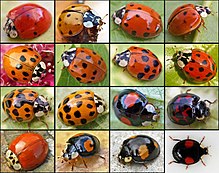Table of Contents
Group 4
Invasive species, parasites and intraguild predation
Wiki site of the practical exercise of the IV Southern-Summer School on Mathematical Biology.
Here you will find the exercise assignment and the group's products.
If you are a group member login to edit this page, create new pages from it, and upload files.
Introduction
The predator harlequin ladybird has been introduced as a pest control in many parts of the world, but became a pest itself. These beetles proved to be very sucessful invaders that outcompete local species of ladybirds in North America and Europe.
Vilcinskas et al. (2013) proposed that harlequins carry high loads of a parasitic fungus that does not harm them seriously. Nevertheless, the fungus is highly noxious to native species of ladybirds that got infected as they attack harlequin's eggs, imatures and adults.
Assignment
Propose a model of intraguild predation to describe the effects proposed by Vilcinkas et al. (2013).
Suggested questions
- Is coexistence of intraguild predators posible?
- Does the proposed effect of invasive harlequins always impairs coexistence?
- Should the dynamics of the transmission of fungus be included in the model?
References
- Vilcinskas, A., Stoecker, K., Schmidtberg, H., Röhrich, C. R., & Vogel, H. (2013). Invasive harlequin ladybird carries biological weapons against native competitors. Science, 340(6134), 862-863. link
- Vilcinskas, A., Stoecker, K., Schmidtberg, H., Röhrich, C. R., & Vogel, H. (2013). Response to Comments on “Invasive Harlequin Ladybird Carries Biological Weapons Against Native Competitors”. Science, 341(6152), 1342-1342. link

